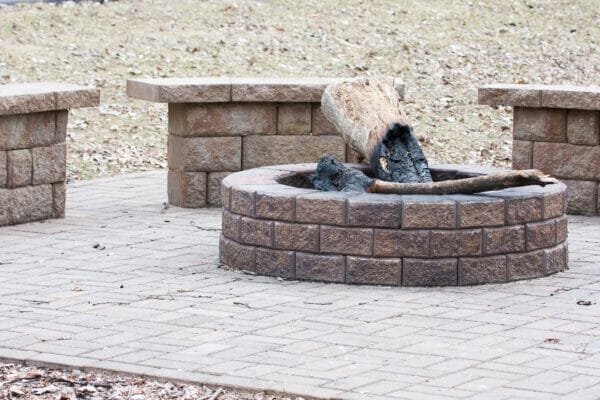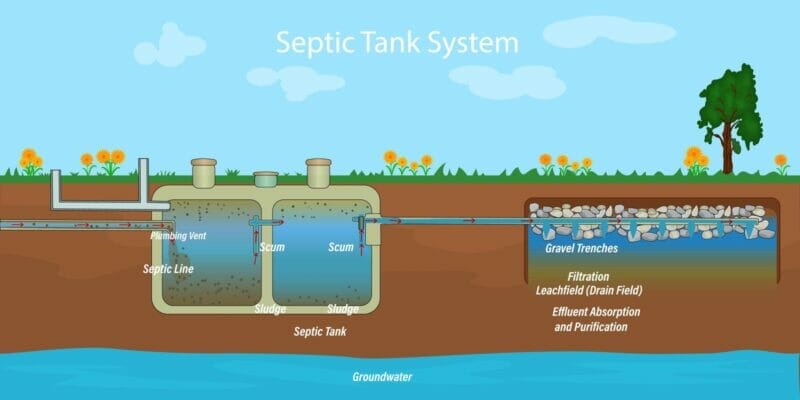Disclaimer: This post may contain affiliate links, meaning we get a small commission if you make a purchase through our links, at no cost to you. For more information, please visit our Disclaimer Page.
Placing a fire pit over your septic tank is a recipe for disaster. Bacterial activity in the septic tank generates highly combustible methane gas. Do not bring fire starters or flames near your septic tank to avoid a fire or an explosion.

Table of Contents
How Far Should My Fire Pit Be From My Septic Tank?
As far as possible is a fair description of the distance you should adhere to. Note that a septic tank’s minimum distance from the house is 10 feet for a more accurate context. The leach field should be 20 feet from the house.
Disturbances above the drain field are particularly damaging, and you risk melting its draining pipes if you build a fire pit just over it. You can avoid this danger by using an elevated fire pit. Because soil compaction limits the proper drainage of the leach field, avoid heavy traffic to and from the fire pit.
If you must set up a fire pit in your yard, do it far away from the septic tank to avoid triggering a fire or an explosion.
Can You Put Anything On Top Of A Septic Tank?
The situation of septic tanks between 4 inches and 4 feet underground does not mean any kind of object or structure can be put on it.
In order to preserve the integrity and function of your septic system (the septic tank and drain field), you must pay attention to what you should or shouldn’t place on it.
Septic systems are built to break down organic waste from home. The septic tank separates the waste into a solid (sludge) scum and liquid (effluent.)
While the solid sludge settled at the bottom of the tank is pumped out at regular intervals, the wastewater is cleaned and used as agricultural irrigation or simply discharged into a septic field.
A septic field is commonly made of perforated pipework set in gravel trenches and buried about 1 to 2 feet underground, with soil and aggregates.
A major risk associated with putting anything over the drain field is causing the lines to collapse. The soil around the trenches can be compressed, making percolation difficult.

Things You Can Put On Top Of A Septic Tank And Drainfield
Although the field is frequently left empty to cut systemic damage, they advised that a layer of vegetation, such as a lawn be planted over it. This is to hold dirt in place and improve the system’s effectiveness. The vegetation both beautifies the septic field and helps the septic system.
Here is a description of the things you can put:
- Shallow-root herbaceous plants: This refers to flowering annuals and perennials like weeds, turfgrass, and many groundcovers. Some species that you can plant include boxwood shrubs, holly shrubs, wild violets, spring bulbs, and hollyhocks.
- Shallow-root trees, like cherry and dogwood: They should be planted within 10 to 20 feet of the drain field. I recommend you erect a root barrier to protect the septic system and the trees from each other.
- Open air kennel: You can set up an open air kennel for your dog to run around in Maintain a plain design, with no roof or floor. Dig holes and install the fence posts away from the drainfield pipes.
- A lightweight swing set: Playground equipment like this is usually intended only for under-10 kids because of its small size.
- A fence: With a blueprint of your septic system, you can put up a fence. You just have to set the posts away from any pipe.
Precautions To Take When Planting Vegetation
- Plant low-maintenance species to reduce activity and foot traffic in the area.
- To maintain soil moisture and evaporation, limit the amount of mulch on the ground to a bare minimum.
- Add more soil over the field only in the event of restoring an eroded area.
- Do not till excessively because the drain lines may be very close to the surface.
- Prevent direct exposure of your skin to the soil as it may harbor harmful organisms. Wear gloves for all processes of gardening.
- The height of any tree planted should match its distance from the septic tank; a 10-feet-tall tree should be at least 10 feet away from the septic tank.
Things You Should Not Put Over Your Septic Tank.
The area above your septic system is not designed to accommodate certain items and structures. It costs too much money to fix a broken septic tank or install a new one.
Avoid spending more than you bargained for and note some things you should never put over your septic tank and drain field:
Deep-rooted vegetation like Japanese willow shrubs, birch trees, aspen trees, birch trees, and blue mist spirea. They can obstruct the normal functioning of the septic system.
Don’t allow the beauty of a vegetable garden and the promise of fertilizer that a drainfield can provide to tempt you into planting a garden in these areas.
Bacteria that cause food contamination, such as E. coli, can be absorbed through the roots of plants.
Structures, including small sheds, floating decks, gazebos, and sheds, have no business being built in these areas. They limit access to the tank when it is time to pump and clean it.
Other things to consider:
- You should never drive or park on your drainfield.
- Don’t build basketball or tennis courts over your septic tank.
- Beware of grazing animals. They consume the protective foliage that covers your drain field, exposing the components of the septic system.
Can I Build A Septic Tank Above Ground?
Above-ground septic tanks are also called holding tanks or camper septic tanks. They are storage tanks for wastewater and are kept above the ground.
These portable polyethylene tanks come in 250- and 350-gallon sizes (946 liters to 1325 liters) and are ideal for temporary sewage storage in certain situations.
This kind of septic tank is also appropriate in water-front areas where installing a standard underground septic system is impossible. There are very few permanent above-ground tanks in use because of the following disadvantages:
- If they are paired with a leaching field, a pump (instead of gravity) transports the wastewater to the field. The solids can be divided into smaller portions, escape with the effluent, and eventually block the pipes connecting to the field.
- If they do not connect the tanks to a leaching field, they will require regular emptying (more frequently than an underground septic tank.) This is expensive and inconvenient.
- Their exposure to the elements causes them to wear out faster than the underground tanks.
How Do I Hide My Above-Ground Septic Tank?
It is possible to combine functionality and beauty in the setting of an above-ground septic tank. You can place lightweight ornaments or items around your tank.
They should also be easily removed when you need access to your above-ground septic tank.
Some of these ornaments include statues and potted plants. You can plant tall native grasses with fibrous roots around the tank to conceal the tank. Remember to use shallow-rooted grasses that won’t affect the septic system.
Filling cut wine barrels with flowers is a pretty way to get the job done.
The easiest solution is to paint the tank the same color as its surrounding. This camouflages your tank without interrupting its functioning.
References:
https://www.epa.gov/septic/how-care-your-septic-system
6 Things to Know About Landscaping Around Your Septic Tank
